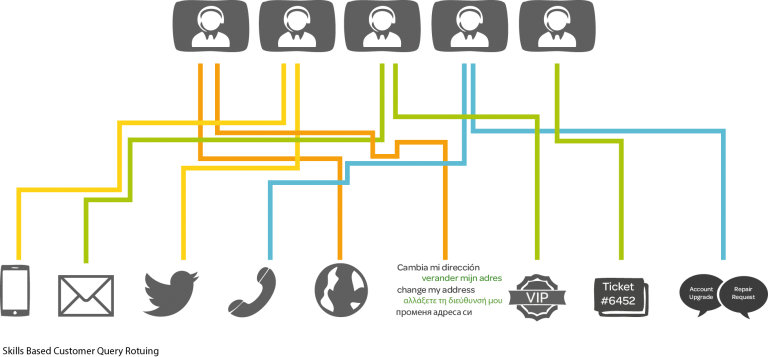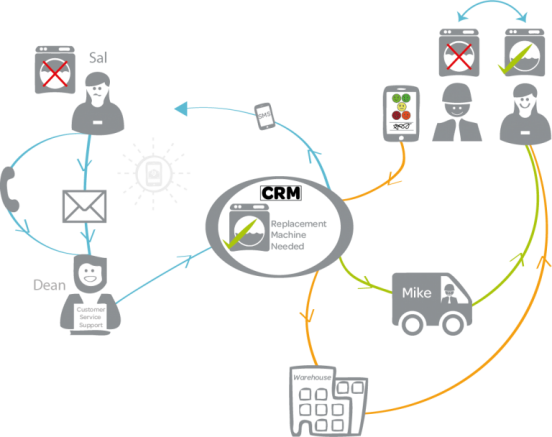The Future of Intelligent Customer Routing
 Routing customer queries to the best skilled agent to deal with them is the foundation of every contact centre. As consumers continue to increase the amount of channels they communicate with the company via, it becomes increasingly difficult, and yet crucial, for contact centres to assign them in a timely manner. For example: after speaking to an agent on web chat, the customer would expect to have their query routed to the same agent on the phone later down the line.
Routing customer queries to the best skilled agent to deal with them is the foundation of every contact centre. As consumers continue to increase the amount of channels they communicate with the company via, it becomes increasingly difficult, and yet crucial, for contact centres to assign them in a timely manner. For example: after speaking to an agent on web chat, the customer would expect to have their query routed to the same agent on the phone later down the line.
Contact centres have moved on from the days of hunt groups and least occupied agent routing, to more dynamic and intelligent techniques. This article will look at the most effective & efficient ways of routing enquiries based on agents’ skillsets in the contact centre and how they can be taken a step further to embrace innovation of software solutions for contact centres.
Skills Based Routing
The most common method of routing customer queries in the contact centre today is skills based. This is driven by the agent’s skillset and what the customer requires from them, e.g.: whether a payment or a delivery. One method of skills-based routing is for the system to conduct data look-ups and then cross reference the customer’s details to detect the skillset necessary for the query; it then routes the customer to the next available appropriately skilled agent.
Another popular skills-based routing method is to have the system identify keywords or numbers in written correspondence, such as emails or social media, from the customer. This ensures that these channels, as well as calls, are routed back to the agent who dealt with the issue initially, or alternatively, someone with the best skillset for it.
Demographic filtering is also widely used within skills-based routing; this allows queries to be assigned to agents with particular language or geographical skills. Where cloud based contact centre software is deployed, companies are able to create a local presence in global markets, thus allowing them to tailor their service, regardless of location, and therefore build customer loyalty.

One Step Further
In order to maintain a competitive edge in today’s age of the autonomous customer, leading companies are now deploying solutions that enable contact centre staff to configure routing, queuing and complex omni-channel workflows themselves, while simultaneously automating business processes. What this means is that the solution will perform the above mentioned routing methods, plus others, while eliminating time consuming manual processes that usually need to be carried out by the IT department at great costs, lengthy appointments and complex coding. Solutions such as this make it easy for contact centre supervisors to set up and configure communication follow-ups from various channels.
With barely many solutions on the market, mplsystems’ Omni-Channel Process Designer is unique in the sense that it offers a user friendly drag and drop design, which allows users to configure, change and recreate workflow processes on an ad hoc basis. This allows customer routing within the contact centre to be agile and attentive to successful progression.

An example case of a successful workflow process can be seen in the above diagram, which shows the customer journey of Sal, who has a broken washing machine. This particular workflow sees Sal emailing and then calling the customer service desk to report her problem, here, the software groups her activities for optimum productivity within the contact centre. Her request is routed to Dean, an agent that has dealt with Sal before and is therefore familiar with her account details. Upon deciphering that the washing machine cannot be repaired, Dean selects ‘replacement machine’ in the CRM system; this then automatically triggers the warehouse to dispatch a new washing machine to Sal’s house and also automatically schedules an engineer, Mike, to visit Sal on the same day that the device is due to arrive; as he was visiting that area already.
Once Mike has fitted the new machine and ensured that Sal is happy with everything, he asks her to complete a customer satisfaction survey on his tablet, which transmits all of the entered data back into the company’s CRM. The updated system then sends Sal an automated SMS to notify her that her request case has now been closed. Sal would also receive an automated confirmation SMS at each stage of the process to give her ongoing real-time updates throughout. This is a simple example of how skills based routing and a configured workflow process can deliver the highest quality of efficiency within customer service with little effort from the agent.
Therefore, the future of customer routing is strategising an intelligent contact flow within the contact centre itself. Solutions, such as the Omni-Channel Process Designer, allow flexibility in the routing process, which is essential to adapting to customer behaviour flow. Being responsive is fundamental for high levels of customer satisfaction without significant costs, and with customer experience at the heart of every interaction today, it is crucial to have a system that will transcend this in every feature that it offers.
 Additional Information
Additional Information
For additional information on mplsystems Skill Based Routing visit their Website



